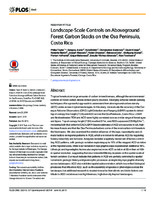Mostrar el registro sencillo del ítem
Landscape-scale controls on aboveground forest carbon stocks on the Osa Peninsula, Costa Rica
| dc.contributor.author | Taylor, Philip | |
| dc.contributor.author | Asner, Gregory | |
| dc.contributor.author | Dahlin, Kyla | |
| dc.contributor.author | Anderson, Christopher | |
| dc.contributor.author | Knapp, David | |
| dc.contributor.author | Martin, Roberta | |
| dc.contributor.author | Mascaro, Joseph | |
| dc.contributor.author | Chazdon, Robin | |
| dc.contributor.author | Cole, Rebecca | |
| dc.contributor.author | Wanek, Wolfgang | |
| dc.contributor.author | Hofhansl, Florian | |
| dc.contributor.author | Vilchez-Alvarado, Braulio | |
| dc.contributor.author | Townsend, Alan | |
| dc.contributor.author | Malavassi-Ortíz, Edgar | |
| dc.date.accessioned | 2017-06-05T15:50:08Z | |
| dc.date.available | 2017-06-05T15:50:08Z | |
| dc.date.issued | 2015-06 | |
| dc.identifier | https://journals.plos.org/plosone/article?id=10.1371/journal.pone.0126748 | es |
| dc.identifier.issn | 19326203 | |
| dc.identifier.uri | https://hdl.handle.net/2238/7177 | |
| dc.description | https://www.scopus.com/inward/record.url?eid=2-s2.0-84935512899&partnerID=40&md5=bcbc9c84ecbc145c0f0e4f1076020baf | es |
| dc.description.abstract | Tropical forests store large amounts of carbon in tree biomass, although the environmental controls on forest carbon stocks remain poorly resolved. Emerging airborne remote sensing techniques offer a powerful approach to understand how aboveground carbon density (ACD) varies across tropical landscapes. In this study, we evaluate the accuracy of the Carnegie Airborne Observatory (CAO) Light Detection and Ranging (LiDAR) system to detect top-of-canopy tree height (TCH) and ACD across the Osa Peninsula, Costa Rica. LiDAR and field-estimated TCH and ACD were highly correlated across a wide range of forest ages and types. Top-of-canopy height (TCH) reached 67 m, and ACD surpassed 225 Mg C ha-1 , indicating both that airborne CAO LiDAR-based estimates of ACD are accurate in tall, high-biomass forests and that the Osa Peninsula harbors some of the most carbon-rich forests in the Neotropics. We also examined the relative influence of lithologic, topoedaphic and climatic factors on regional patterns in ACD, which are known to influence ACD by regulating forest productivity and turnover. Analyses revealed a spatially nested set of factors controlling ACD patterns, with geologic variation explaining up to 16% of the mapped ACD variation at the regional scale, while local variation in topographic slope explained an additional 18%. Lithologic and topoedaphic factors also explained more ACD variation at 30-m than at 100- m spatial resolution, suggesting that environmental filtering depends on the spatial scale of terrain variation. Our result indicate that patterns in ACD are partially controlled by spatial variation in geologic history and geomorphic processes underpinning topographic diversity across landscapes. ACD also exhibited spatial autocorrelation, which may reflect biological processes that influence ACD, such as the assembly of species or phenotypes across the landscape, but additional research is needed to resolve how abiotic and biotic factors contribute to ACD variation across high biomass, high diversity tropical landscapes. | es |
| dc.language.iso | eng | es |
| dc.publisher | Public Library of Science | es |
| dc.rights | acceso abierto | es |
| dc.rights.uri | https://creativecommons.org/licenses/by-nc/3.0/cr/ | * |
| dc.source | journal.pone.0126748 June 10, 2015 | es |
| dc.subject | Carbón | es |
| dc.subject | Clima | es |
| dc.subject | Bosques | es |
| dc.subject | Geología | es |
| dc.subject | Geomorfología | es |
| dc.subject | Paisaje botánico | es |
| dc.subject | Research Subject Categories::NATURAL SCIENCES::Biology::Terrestrial, freshwater and marine ecology::Terrestrial ecology | es |
| dc.title | Landscape-scale controls on aboveground forest carbon stocks on the Osa Peninsula, Costa Rica | es |
| dc.type | Artículo original | es |
Ficheros en el ítem
Este ítem aparece en la(s) siguiente(s) colección(ones)
-
Artículos [37]



